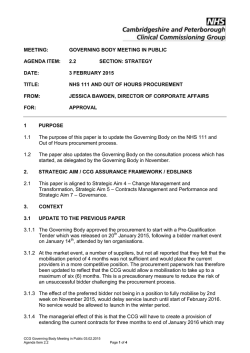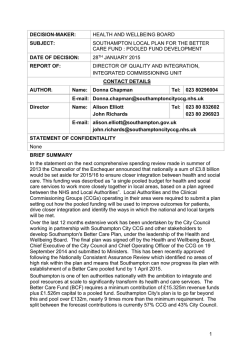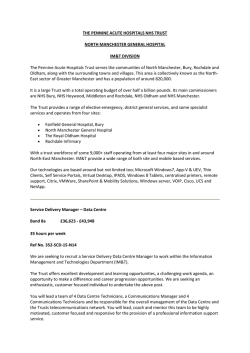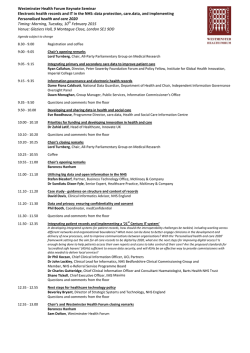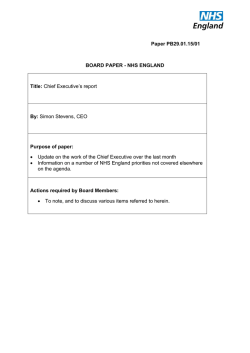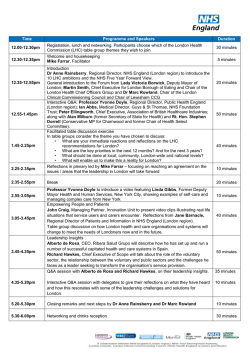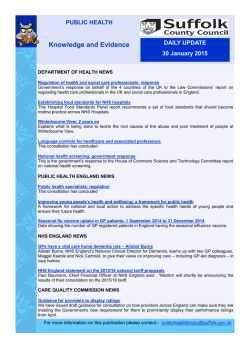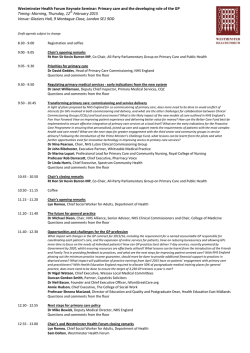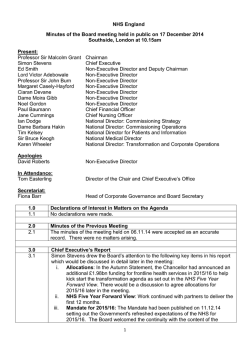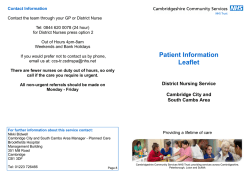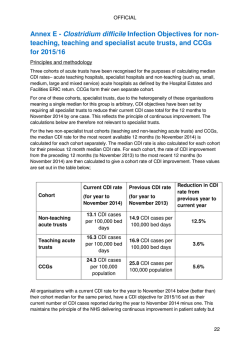
Subject: Draft Financial Plan 2015/16 Presented by: John Ingham
Agenda Item: 11.2 Subject: Draft Financial Plan 2015/16 Presented by: John Ingham, Chief Financial Officer Submitted to: NHS West Norfolk CCG Governing Body, 29 January 2015 Purpose of Paper: For information and discussion Executive Summary: The CCG maintains a five year financial planning model that provides a view of future financial sustainability and QIPP (Quality, Innovation, Productivity, Prevention) saving requirements. This financial model has been updated in the light of NHS England Planning Guidance for 2015/16 and revised CCG allocations, both published in late December 2014. This paper outlines the impact for West Norfolk of the recent national funding announcements for CCGs (which results in additional funding of £3.6m for West Norfolk CCG), and highlights key financial impacts of the Planning Guidance (which utilise most of this increased funding). It then illustrates the current 2015/16 financial plan, which results in a QIPP target of £7.5m (3.3% of allocation), and identifies key financial risks not currently addressed within the planning assumptions. Finally, this report outlines the key steps over coming months in the production of a financial plan for 2015/16 which includes milestones for delivering financial template returns to NHS England; the first such milestone was 13 January, which was an initial summary return that reflected the picture described in this report. The final 2015/16 budget will be presented to the March Governing Body for approval. KEY RISKS Clinical: None Finance and Performance: Delivery of financial balance is a statutory duty for CCGs Impact Assessment (environmental and equalities): None Reputation: Failure to deliver a 1% surplus in 2015/16 in line with NHS England expectations would bring an increased level of scrutiny and would impact on the CCG’s reputation. Legal: None Patient focus (if appropriate): None Reference to relevant Governing Body Assurance Framework: 2.1,3.1,3.2 RECOMMENDATION: The Governing Body is asked to note the impact of the recent NHS funding announcements and national guidance, and to comment on the CCG’s draft financial plan for 2015/16. 1 1. Introduction 1.1 The CCG has maintained a five year financial planning model that helped to inform both NHS England returns in 2014 and also the work for the McKinsey Contingency Planning Team (CPT) as they establish the baseline financial position for the West Norfolk health system. 1.2 The financial model has now been updated in the light of NHS England Planning Guidance for 2015/16 and revised CCG allocations, both published in late December 2014. 1.3 This paper outlines the resulting draft CCG financial plan for 2015/16, which will continue to be refined throughout February and March before being presented to the March Governing Body for approval. 2. CCG Allocations 2.1 In December 2013 the NHS England Board agreed two year CCG allocations for 2014/15 and 2015/16, with the previous funding formula having been adjusted to include weightings for unmet need and inequalities. The formula still does not reflect issues relating to rurality or small acute hospitals; however the NHS England Head of Financial Strategy and Allocations has recently visited Norfolk to discuss these issues with the Chief Financial Officers of North & West Norfolk CCGs as there is national consideration of the inclusion of these elements in future iterations of the funding formula. 2.2 The Chancellor’s Autumn Statement on 3 December 2014 confirmed £1.98bn of additional funding for the NHS in England in 2015/16, to be split as follows: 2.3 The NHS England Board on 17 December 2014 determined the approach for allocating the £1.50bn for front-line commissioning, of which £1.1bn has been added to the previously published CCG allocations. Three key principles were established: 2.4 £1.50bn direct to front-line commissioning of services; £0.20bn national Transformation Fund to support local health economies in the development of the new care models set out in Simon Stevens’ “Five Year Forward View”; £0.25bn Primary Care & Out of Hospital Care infrastructure fund (revenue and capital); £0.03bn for development of Eating Disorder Services. No CCG to receive less funding in cash terms in 15/16 than was previously agreed in the December 13 publication (other than any recurrent baseline changes agreed in 2014/15); All CCGs to receive at least real terms growth of 1.4% (revised GDP deflator) and their fair share of the £350m resilience funding previously retained centrally and distributed nonrecurrently each year (ie “winter monies”); The remaining funding is to support the pace of change towards target allocations so that those CCGs that are most below target funding get the most significant share of the additional funding. The resulting position for West Norfolk CCG is summarised below together with a comparison against the average for all CCGs in East Anglia: Description Increase on previously notified allocation for 2015/16 Overall growth in Programme (commissioning) funding vs 2014/15 recurrent baseline Amount of growth badged for Operational Resilience 2015/16 distance from target funding (as per December 2013 indicative allocations) Revised 2015/16 distance from target funding (as per December 2014 allocations) West Norfolk CCG 1.7% (£3.6m) East Anglia average 2.1% 3.4% (£7.2m) 4.1% £1.2m £14.8m 0.5% below target 1.8% below target 0.8% below target 1.4% below target 2 In terms of distance from target funding it should be noted that NHS England’s current pace of change policy focuses on CCGs that are more than 5% below target, so the current West Norfolk CCG position should be regarded as effectively at target funding. 2.5 One funding issue that is unchanged from the December 2013 publication is the allocation to CCGs of funding historically held by NHS England for transfers to Social Care; from April 2015 this forms part of the funding that CCGs are required to put into the Better Care Fund (BCF). The relevant figure for West Norfolk CCG is £3.6m. 2.6 Allocations for running costs are unchanged from those previously published in December 2013, which reflected a 10% reduction for all CCGs for 2015/16. For West Norfolk CCG this entire reduction is covered by the reduced costs of the North East London Commissioning Support Unit (NELCSU) arrangement that came into place from October 2014, which was agreed on the basis of a 20% reduction on the previous costs of Anglia CSU (a 20% reduction in CSU costs equates to a 10% reduction in overall running costs). This enables the CCG to maintain its current level of expenditure on other areas of running costs such as directly employed CCG staff and Governing Body costs. 2.7 In order to support the national policy of co-commissioning for primary care and specialised services, NHS England has also published notional budgets at CCG level for these services. 2.8 The resulting West Norfolk CCG recurrent allocation for 2015/16 is as follows: Description £m CCG Actual Allocation 2015/16 Recurrent Programme funding 2014/15 Recurrent Programme growth 2015/16 Recurrent baseline funding 2015/16 Better Care Fund allocation 2015/16 Total Programme Allocation 2015/16 Running Costs Allowance 2015/16 TOTAL CCG RECURRENT ALLOCATION 2015/16 213.2 7.2 220.4 3.6 224.0 3.7 227.7 Notional Allocations Primary Care indicative baseline: GP services 26.3 Primary Care indicative baseline: Other 11.3 Primary Care total 37.5 Specialised Services mapped to CCG level 32.9 Total Notional Allocation 70.4 Grand Total including Notional Allocation 298.1 3 3. Key Financial Aspects of National Guidance for 2015/16 3.1 In November and December 2014 the following documents were produced to support the planning process for 2015/16: 3.2 “The Forward View Into Action: Planning for 2015/16” (published by NHS England); “2015/16 National Tariff Payment System: A consultation notice” (published by Monitor). Key financial headlines for 2015/16 from these documents, and the resulting local position, are as follows: To support parity of esteem between mental and physical health by 2020 “we expect each CCG’s spending on mental health services in 2015/16 to increase in real terms, and grow by at least as much as each CCG’s allocation increase”. Given that West Norfolk’s recurrent allocation is rising by 3.4%, the cost impact for WNCCG in 2015/16 is estimated at £0.7m. This would need to cover a number of other requirements in the Planning Guidance such as meeting new access and waiting time standards for psychosis and IAPT (Improving Access to Psychological Therapies) services, ensuring “adequate and effective levels of liaison psychiatry services in acute settings” and working with other local commissioners “to invest in community child and adolescent mental health services” (CAMHS); Financial assumptions are expected to be realistic and to be aligned between NHS commissioners and providers. The local CPT process has facilitated early discussion on activity and financial assumptions between the CCG and acute and community providers, so this requirement is being met; There is expected to be “a sound financial position across the health economy with headroom to support transformation. Financial planning is (to be) resilient and long-term”. Again, the local CPT process should help to fulfil this expectation; The 2015/16 tariffs do not include specific additional resources for seven day working, so “all acute providers of acute care should agree service delivery and improvement plans (SDIPs) with commissioners, setting out how they will make further progress in 2015/16 to implement at least 5 of the 10 clinical standards for seven day services, within the resources available”. This should therefore not be a specific cost pressure for the CCG in 2015/16, although discussions are on-going with providers; As 2015/16 CCG allocations now include recurrently the funding for operational resilience (£1.2m for West Norfolk), the NHS England document states that “unless and until it is clear that demand has reduced, we strongly advise system resilience groups (SRGs) not to switch off additional winter capacity for urgent and emergency care”. This requirement will be reviewed by the West Norfolk SRG as part of its evaluation of the 2014/15 winter resilience schemes; The tariff deflator for 2015/16 is expected to be -1.9% (inflation of +1.9% being offset by a 3.8% efficiency requirement of providers). However the Monitor document also suggests a significant rise in the costs of Clinical Negligence Scheme for Trusts (CNST) for acute providers, leading to a reduced acute deflator of -0.8%. This is still to be verified by detailed workings when the final national tariff prices are published in January, but the changes in tariff are currently anticipated to cost the CCG an additional £0.8m compared to previous estimates; The marginal rate for acute non-elective activity above the agreed baseline (based on 2008/09 activity levels) will be increased from 30% to 50% of tariff. The financial impact for West Norfolk CCG is estimated to be around £0.5m in 2015/16. Also “Commissioners and providers must jointly agree plans for spending the 50% balance, which should be targeted towards investment to reduce the level of non-elective admissions. 4 We expect the plans to be published on the commissioners’ website by no later than 30 April 2015”. This requirement will need to be discussed by the West Norfolk SRG, but in practice the marginal rate credit has historically been invested recurrently in a range of community services such as community matrons, 111 services, Dementia services, and now the Virtual Ward; 3.3 The document is clear that “there will be no further in-year allocations during 2015/16” for issues such as operational resilience, which have historically been funded non-recurrently each year; The same business rules apply as previously notified by NHS England, ie “all commissioners must set aside 1% non-recurrent spend in 2015/16” as well as setting aside at least 0.5% contingency reserve and planning to deliver a 1% surplus. These issues are all reflected in the CCG financial plan. The overall financial impact for the CCG of the new funding outlined in Section 2 and the new requirements outlined above is as follows. This shows that whilst the increase in funding appears to enable the CCG to meet the key financial impacts of the Planning Guidance, it does not enable the CCG to materially reduce its QIPP (Quality, Innovation, Productivity and Prevention) savings target for 2015/16. Description Additional programme funding 2015/16 (over and above previously notified allocation) Less additional commitments from Planning Guidance: Real terms growth for Mental Health services Operational Resilience funding Changes to national tariffs (including CNST impact) Increased marginal rate for non-elective activity Net increase / (decrease) in CCG funding £m 3.6 (0.7) (1.2) (0.8) (0.5) 0.4 4. Indicative 2015/16 Financial Plan 4.1 The CCG’s current draft 2015/16 financial plan starts from the 2014/15 forecast outturn position as at month 8, and then applies the following adjustments: Non-recurrent costs and allocations from 2014/15 are removed, and the full year costs of new initiatives commenced in 2014/15 are added back in; Tariff deflators are applied to the revised recurrent baseline; Growth factors are applied for both demographic and non-demographic growth; Specific known cost pressures and investments are added in, a particular area for 2015/16 being the BCF; Non-recurrent spend for 2015/16 is added in. This gives a total anticipated expenditure for the year that is compared to the total allocation, the difference being the CCG QIPP target, as shown in the table below. 5 CCG Financial Plan Summary 2015/16: Description 2014/15 Forecast £m 2015/16 Plan £m Revenue Recurrent Programme Funding Running Costs Allowance Return of previous year's surplus 216.8 2.1 224.0 3.7 2.2 Total Revenue 223.0 229.9 4.1 Baseline Expenditure (14/15 after QIPP savings, 15/16 before QIPP savings) Programme Spend Acute Commissioning Mental Health Commissioning Continuing Healthcare Community Commissioning (including BCF) Prescribing / Primary Care Reserves (see note *) Total Running Costs Total Expenditure before savings Planned Surplus / (Deficit) before savings 216.9 125.2 17.3 14.7 27.5 37.5 8.8 230.9 3.9 4.2 220.8 235.1 124.7 16.7 14.4 22.2 36.4 2.6 2.2 (5.2) Annual QIPP requirement to deliver 1% surplus (0.0) (7.5) Cumulative total QIPP savings (0.0) (7.5) 2.2 2.3 Planned Surplus/(Deficit) for Year as % of Programme funding 1.0% 1.0% Annual Savings (QIPP) requirement as a % of CCG allocation 0.0% 3.3% Planned Surplus / (Deficit) for Year * Note: the Reserves figure for 2015/16 currently includes the following elements - Operational Resilience funding (£1.2m), 0.5% Contingency reserve (£1.1m), 1% Non-Recurrent reserve (£2.3m), reserve for practice plans re £5 per head funding (£0.8m), 1% Cost Pressures reserve (£2.4m), and BCF Performance Fund (£1.0m – this is a contingency being held in case the BCF does not deliver the targeted level of savings in acute care, as per national BCF guidance). As contractual discussions progress and commissioning plans are crystallised, elements of these reserves will transfer into other Programme budget lines. 6 The key assumptions underpinning the above financial plan are as follows: Description Net tariff deflator: Acute contracts (inc CNST impact) Non-acute Activity growth: Demographic growth (all services) Non-demographic growth: acute services Non-demographic growth: other providers Non-demographic growth: Continuing Healthcare Non-demographic growth: GP prescribing Other cost pressures (in addition to demographic growth): Non-tariff drugs / Direct Access Pathology growth Ambulance 999 activity Reserves (as % of allocation): Contingency Reserve Non-Recurrent Reserve Cost Pressures / investments 2015/16 Assumption Rationale -0.8% -1.9% As per NHS England guidance. 1.3% 0.4% Nil 8.7% As agreed via CPT process. 3.7% Gives total growth of 10% in line with historic trend. Gives total growth of 5% in line with historic trend. 8.7% 1.5% In line with historic trends. 0.5% 1.0% 1.0% National expectation. National expectation. Pressures from national mandates or local priorities. 4.2 The movement between 2014/15 forecast 1% surplus and 2015/16 planned 1% surplus is illustrated in Appendix A; this shows the planned utilisation of the growth in funding in 2015/16 and the level of QIPP savings needed to deliver a 1% surplus. 5. QIPP Requirements 2015/16 5.1 As shown in 4.1 above, the CCG’s QIPP requirement for 2015/16 is estimated to be £7.5m (3.3% of total expenditure). Whilst there are a number of schemes being developed by the CCG, this is still a very challenging target, especially in the context of historical QIPP delivery in the region of 2%. 5.2 Key areas for QIPP savings in non-acute services are: Prescribing, where plans to deliver a £1.1m QIPP target in 2015/16 are well advanced via a new Prescribing Quality Scheme; Continuing Health Care (CHC) where some initiatives have been identified to mitigate the anticipated 10% growth in spend (to bring this down to a demographic level of growth would yield annual savings of £1m) but further work is needed to bring these to fruition; Integrated Community Equipment Services (ICES) where a review of equipment utilisation and returns is underway; and Reductions in CSU costs that are necessary to enable the CCG to live within a 10% lower Running Cost Allowance in 2015/16. 5.3 This still leaves the significant sum of around £4.5m to be met from acute services. A number of initiatives are being developed by the CCG, including reductions in emergency admissions as a result of work under the BCF, a review of Prior Approval thresholds and policy application, consideration of support for practices in reviewing referrals for elective care, and additional contractual/transactional measures. However the majority of this acute QIPP requirement will need to come from the transformation of services and is therefore an intrinsic part of the current CPT process focussed on the QEH. There will be a time-lag though in the implementation of any such initiatives, so alternative schemes will be needed to address the remaining gap in 2015/16. 5.4 In all of these areas the CCG is working through a robust governance process to scope, develop and agree individual plans, and this work needs to reach conclusion by the end of February in order to deliver an achievable QIPP plan for 2015/16. 7 6. Key Financial Risks 6.1 Whilst a number of financial risks are addressed in the CCG’s planning assumptions, there remain other significant risks for which provision has not yet been made. Key risks, and current mitigations, are as follows: Risk Under-delivery of challenging QIPP target QEH CPT process leads to tariff premium payments for commissioners Rebasing of Ambulance costs between CCGs in East of England (potential full year cost of £1m to WNCCG) Acute activity growth Continuing Healthcare (CHC) activity growth Operational pressures (eg delivery of performance in A&E & waiting times) Contract settlements in excess of current plan level Mitigations currently in place Robust QIPP process that has been reviewed by internal audit; pipeline of new schemes; synergy with CPT process around QEH All partners in the CPT process have acknowledged that this is a step of last resort and would not represent a successful outcome to the CPT process Chief Officer-level discussions on-going; if rebasing is agreed through this process then a transitional period would be applied to spread the impact over time Plan allows for growth of 1.7% (before QIPP) Plan allows for growth of 10% (before QIPP) Operational resilience funding set aside in CCG plan (though at a lower level than the totals received in 2013/14 and 2014/15) for management by the SRG CCG is in on-going dialogue with all main providers 6.2 Further mitigation for these pressures is available as the CCG plan includes a 1% Cost Pressures reserve (£2.3m), however this is a relatively small sum compared to the scale of issues listed above. 6.3 Some of these risks may crystallise before the end of March such that they will be reflected in the final financial plan for 2015/16; other remaining risks will continue to be reported to the Governing Body throughout 2015/16. 7. Next Steps 7.1 NHS England has published a timetable for CCGs to submit 2015/16 (and 5 year) financial plans for review. The key milestones within this are: 13 January Submission of initial draft financial plan template to NHS England (which was met by the CCG); 13 February Checkpoint for progress with plans (which entails a first full draft submission of the NHS England template); 27 February Submission of full draft plans to NHS England; 27 February – end March NHS England assurance of draft plans; By 31 March plans approved by CCG Governing Body; 10 April submission of full final plans to NHS England. 7.2 Contract negotiations with all main providers are on-going during January and February, and the outcome of these negotiations will confirm the accuracy of some of the estimates included in this current draft plan. It will also help to inform an assessment of financial risks for 2015/16. 7.3 The final budget and QIPP plan for 2015/16 will be brought to the March Governing Body for approval. In the meantime it should be noted that the CCG expects to initiate meetings of the new Finance & Performance Committee as a non-executive-led scrutiny committee that will give the opportunity for further review of the CCG’s plans prior to submission to the Governing Body for approval. 8 APPENDIX A Bridge between 2014/15 forecast surplus and 2015/16 planned surplus 10 8 6 £m 4 2 (2) (4) (6) 2014/15 forecast surplus £2.2m Non-recurrent adjustments - £1.6m + Recurrent funding growth £6.8m Provider Demographic Other volume Better Care Recurrent QIPP savings efficiency net growth growth Fund cost pressures required of inflation / investments + £1.7m - £2.6m - £3.4m - £3.7m - £4.6m + £7.5m 2015/16 planned surplus = £2.3m 9
© Copyright 2025
